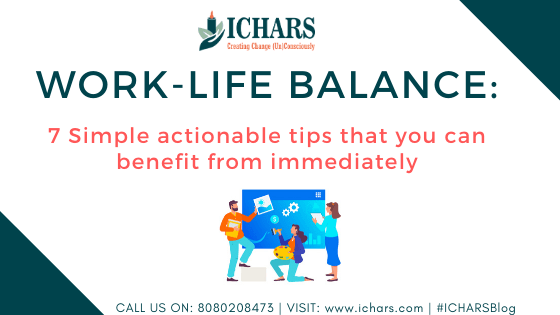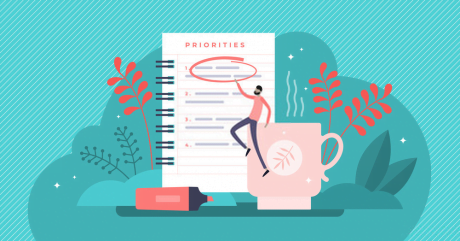Introduction
The importance of Work-life balance is being highlighted in more and more researches. But we don’t even need a research to tell us the importance of work-life balance, do we? It is almost common sense, that over-emphasis on any one area of life in a manner that it affects other areas is not in the interest of anyone concerned.
But the important questions are how do we know that there is a lack of work-life balance in our life and what can we do to create this balance?
Work-Life Balance: Case Study
 Sarita is a multitasker, she starts her day early in the morning, prepares breakfast for everyone, packs their lunches and gets her children ready for school. Once all this is done, she heads for work.
Sarita is a multitasker, she starts her day early in the morning, prepares breakfast for everyone, packs their lunches and gets her children ready for school. Once all this is done, she heads for work.
Her responsibility as a financial advisor in a reputed firm requires her to be focused at all times. Often, she returns home late. As soon as she is home, she has to begin preparations for the next morning.
On weekends, she is busy responding to important emails, making presentations, shopping for groceries and more. All this leaves her with little time for family and none for herself.
Her husband and family constantly complain of her being never there. Children miss her on their school events and her family complains that she barely participates in social functions. All this makes Sarita feel great despair and a sense of worthlessness for not being able to keep anyone happy.
And most importantly, she is left with no time for herself, she skips meals, pays no attention to her physical or mental health and is never able to meet friends. And even when she gets some time to spend with family, she feels exhausted and frustrated.
This phenomenon has become all too common for many of us. If you are finding it more challenging than ever to juggle the demands of your professional and personal life, you are not alone. With increasing competition and human labour becoming easily replaceable, many of us try to put in extra hours.
On top of that technology has brought work into our beds too! Working 24/7 has become a norm.
This means that now, more than ever, it is time for us to learn to develop work-life balance.
What is Work-Life balance about?
Maintaining a work-life balance is about drawing a fine line between your personal and professional life, and not allowing one to spill into the other. Both are important, neither can be neglected.
Another important thing to remember is that work-life balance is not only important for women but equally important for men.
Work-life balance in the lives of employees is also beneficial for the organisation since it leads to higher productivity and more committed employees.
Tips to maintain work-life balance
-
Access what is the current level of imbalance / problem?
Whenever you are trying to create a change in your life, it is always to good to start with having a clear idea of where you are currently and where you wish to be after the change is completed. This allows you to plan for that change more systematically.
 This is also true for creating a work-life balance. Start by paying attention to the amount of time you are spending on the different areas of your life. Maintain a dairy of your daily activities with details about time spent on work, with family, with self, on social media (not related to work) and so on.
This is also true for creating a work-life balance. Start by paying attention to the amount of time you are spending on the different areas of your life. Maintain a dairy of your daily activities with details about time spent on work, with family, with self, on social media (not related to work) and so on.This will give you an understanding of the current state of work-life balance. It will also help you understand whether the imbalance is a result of work or is it a result of social media and other such activities. This will help you understand the nature of change you need to create in your life to create the balance.
-
Describe what does work-life balance mean for you

So after you have accessed the current level of imbalance, the next step to create a work-life balance is to define “what is the meaning of work-life balance for you”.Describe what does a balanced life look like to you. Identify the amount of time you would like to spend on the different areas of your life. Make a not of indicators (observable evidence) that will tell you that you have been able to create this balance in your life.
Once you know the starting point (current level) and the desired outcome (balanced life), it is a lot more easy to understand the specific changes that you need to make in your life, to create the desired balance in life.
-
Make a not of the changes that are required
Compare the present state of things with the desired scenario and make a note of the things that need to change in your life. Identify how you can reduce time spent on areas where more time was being spent.
Explore the different ways of reducing the time spent of these areas. Maybe you need to find better, more efficient ways of doing the same work or need to delegate some work or may be you just need to learn to say no to additional work give the time constraints.
It is also noticed in many cases that when people learn to enjoy their work more, they feel fresh and energetic even after a full days work, which allows them to spend more quality time with the family and in other activities that they enjoy.
This can have a huge impact on how you perceive both your life in general and work-life balance.
-
One Task At A Time
While multitasking has hailed as the greatest skill of our times and most of us take pride in being able to do more than one task at a time. It has almost become fashionable to say someone is a ‘multitasker’.
Do you know that doing more than one task at a time often causes errors, and feels like an overload. Continual multitasking for long periods may lead to stress and adverse effects on both physical and mental health. In addition, you may have to redo the same task more than once to correct the errors caused due to lack of attention to any one task at a time.
It is better to pay attention to one task at a time rather than doing it all at the same time. This way there is a higher likelihood that you would be able to complete all your tasks on time, accurately and efficiently.
The principle of one task at a time also needs to be used when multiple changes are required to create the work-life balance. Create one change at a time from the list created in the previous step. This will make the transition from your current situation to a more balanced life more smooth and comfortable.
Remember, we become comfortable even with a life that lacks balance When we have been living that life for a long time. Creating a work-life balance may require us to move out of this comfort zone. One change at a time makes it easier to expand our comfort zone.
-
Prioritise
 Understanding which tasks are more important and what changes can create a greater degree of work-life balance can help you select the right tasks and changes to begin with.
Understanding which tasks are more important and what changes can create a greater degree of work-life balance can help you select the right tasks and changes to begin with.Doing more important tasks first ensures you do not stress over that and can complete the rest of the work patiently. And taking some time off in between tasks helps you recharge and prepares you for further challenges at work and in life.
-
Take short breaks
Working non-stop will not help you accomplish more. Even a machine would break down if it was run without a break.
If you do not take any time off between tasks, it gradually lowers your productivity. And can even lead to health issues. Taking short and meaningful breaks helps to rejuvenate and recharge body and mind for further challenges at work.
During these breaks, you can –
- Interact with co-workers
- Step out for coffee or lunch with friends
- Leave work on time
- Have a quick chat with your family
Small things like interacting with other people helps you relax. And lunchtime is the perfect opportunity to do so. Step away from your desk and enjoy the company of your friends and colleagues. This may be hard to do at first, but you will soon start feeling the benefits.
-
Visit a Coach or a Therapist
 Helping create work-life balance is one of the key components of life coaching. If you are a an individual who is not able to create or maintain work-life balance, visiting a coach can be extremely beneficial. That said at times, it is difficult to create a work-life balance because of a very high degree of stress, or anxiety and other intense emotions. In such a case it is recommended to work with a trained therapist instead of a coach.
Helping create work-life balance is one of the key components of life coaching. If you are a an individual who is not able to create or maintain work-life balance, visiting a coach can be extremely beneficial. That said at times, it is difficult to create a work-life balance because of a very high degree of stress, or anxiety and other intense emotions. In such a case it is recommended to work with a trained therapist instead of a coach.Feel free to call +91-8080-2084-73 to connect with one of our certified coaches or trained therapists, you can assist you in creating the work-life balance more systematically and naturally.
It may seem difficult to achieve work-life balance as people are constantly pushed to work 24/7 to cope with increasing demands at work. Do not be discouraged however; there are little steps that can be taken to keep your life on the right track.
For Coaches and Therapists
If you are coach who would like to help clients create work-life balance more naturally and effectively, you must learn to incorporate Hypnosis, NLP and Mindfulness based techniques in your coaching practice. So if you are serious about becoming a highly effective coach, you would really benefit by using the Cognitive Hypnotic Coaching™ model with your coachees. The model is designed in a way that you don’t have to separately focus on work-life balance, the model takes care of that for the coachee.
If you are a psychologist, who is looking for better and more effective ways of helping clients manage their emotions and create a work-life balance, you may read more about our Internationally affiliated program that integrates different approaches to psychotherapy into a single comprehensive curriculum.

 This is also true for creating a work-life balance. Start by paying attention to the amount of time you are spending on the different areas of your life. Maintain a dairy of your daily activities with details about time spent on work, with family, with self, on social media (not related to work) and so on.
This is also true for creating a work-life balance. Start by paying attention to the amount of time you are spending on the different areas of your life. Maintain a dairy of your daily activities with details about time spent on work, with family, with self, on social media (not related to work) and so on.
 Understanding which tasks are more important and what changes can create a greater degree of work-life balance can help you select the right tasks and changes to begin with.
Understanding which tasks are more important and what changes can create a greater degree of work-life balance can help you select the right tasks and changes to begin with. Helping create work-life balance is one of the key components of life coaching. If you are a an individual who is not able to create or maintain work-life balance, visiting a coach can be extremely beneficial. That said at times, it is difficult to create a work-life balance because of a very high degree of stress, or anxiety and other intense emotions. In such a case it is recommended to work with a trained therapist instead of a coach.
Helping create work-life balance is one of the key components of life coaching. If you are a an individual who is not able to create or maintain work-life balance, visiting a coach can be extremely beneficial. That said at times, it is difficult to create a work-life balance because of a very high degree of stress, or anxiety and other intense emotions. In such a case it is recommended to work with a trained therapist instead of a coach.